
Switzerland has a dense network of roads and railways. The Swiss public transport network has a total length of 24,500 kilometres and has more than 2600 stations and stops.

Transrapid is a German-developed high-speed monorail train using magnetic levitation. Planning for the system started in the late 1960s, with a test facility in Emsland, Germany inaugurated in 1983. In 1991, technical readiness for application was approved by the Deutsche Bundesbahn in cooperation with renowned universities.
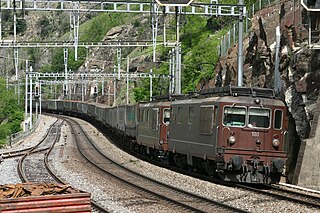
The Bern-Lötschberg-Simplon-Bahn (BLS), known between 1997 and 2006 as the BLS Lötschbergbahn, was a Swiss railway company. In 2006 the company merged with Regionalverkehr Mittelland AG to form a new company called BLS AG.

The Swiss rail network is noteworthy for its density, its coordination between services, its integration with other modes of transport, timeliness and a thriving domestic and trans-Alp freight system. It is made necessary by strong regulations on truck transport, and is enabled by properly coordinated intermodal logistics.
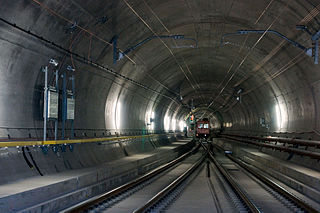
The Gotthard Base Tunnel is a railway tunnel through the Alps in Switzerland. It opened in June 2016 and full service began the following December. With a route length of 57.09 km (35.5 mi), it is the world's longest railway and deepest traffic tunnel and the first flat, low-level route through the Alps. It lies at the heart of the Gotthard axis and constitutes the third tunnel connecting the cantons of Uri and Ticino, after the Gotthard Tunnel and the Gotthard Road Tunnel.

Maglev is a system of rail transport whose rolling stock is levitated by electromagnets rather than rolled on wheels, eliminating rolling resistance.
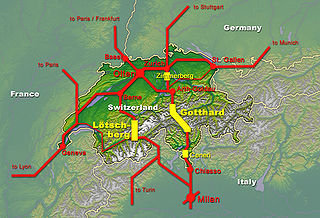
The New Railway Link through the Alps, is a Swiss construction project for faster north–south rail links across the Swiss Alps. It consists of two axes with several improvements along these rails including three new base tunnels several hundred metres below the existing apex tunnels, the 57-kilometre (35 mi) Gotthard Base Tunnel, the 35-kilometre (22 mi) Lötschberg Base Tunnel, and the 15-kilometre (9.3 mi) Ceneri Base Tunnel. Swiss Federal Railways subsidiary AlpTransit Gotthard AG and BLS AG subsidiary BLS Alp Transit AG were founded for this project and built the tunnels.
Various terms are used for passenger railway lines and equipment; the usage of these terms differs substantially between areas:
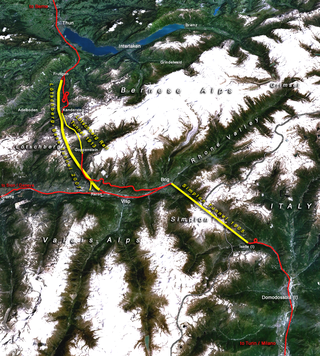
The Lötschberg Base Tunnel (LBT) is a 34.57 km (21.48 mi) railway base tunnel on the BLS AG's Lötschberg line cutting through the Bernese Alps of Switzerland some 400 m (1,300 ft) below the existing Lötschberg Tunnel. It runs between Frutigen, Bern, and Raron, Valais.
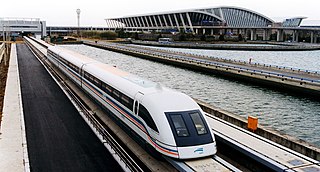
The Shanghai maglev train (SMT) or Shanghai Transrapid is a magnetic levitation train (maglev) line that operates in Shanghai, China. The line uses the German Transrapid technology. The Shanghai maglev is the world's first commercial high-speed maglev and has a maximum cruising speed of 300 km/h (186 mph). Prior to May 2021 the cruising speed was 431 km/h (268 mph), at the time this made it the fastest train service in commercial operation.
A vactrain is a proposed design for very-high-speed rail transportation. It is a maglev line using partly evacuated tubes or tunnels. Reduced air resistance could permit vactrains to travel at very high (hypersonic) speeds with relatively little power—up to 6,400–8,000 km/h (4,000–5,000 mph). This is 5–6 times the speed of sound in Earth's atmosphere at sea level.
The Baltimore–Washington Superconducting Maglev Project (SCMAGLEV) is a proposed project connecting the United States cities of Baltimore, Maryland, and Washington, D.C., with a 40 miles (64 km) maglev train system between their respective central business districts. It is the first segment of the planned Washington-New York Northeast Maglev project. The maglev proposal is not related to the Baltimore–Washington hyperloop proposed by the Boring Company.

The Zimmerberg Base Tunnel (ZBT) is a railway tunnel under the Zimmerberg mountains in Switzerland. Phase I of the tunnel was opened to traffic during April 2003.

Rail 2000 is a large-scale project of the Swiss Federal Railways (SBB CFF FFS) established in 1987 to improve the quality of the Swiss rail network for the New millennium. It includes measures to accelerate a number of existing connections and the modernisation of rolling stock. The federal government decision to support the project in 1986 was approved by a referendum in 1987. In 2004 the first phase was completed consisting of around 130 projects with a budget of around CHF 5.9 billion.

The Guangzhou–Shenzhen–Hong Kong Express Rail Link (XRL), also known as the Guangshengang XRL, is a high-speed railway line that connects Guangzhou and Hong Kong (Kowloon) via Shenzhen.

High-speed rail in Switzerland consists of two new lines and three new base tunnels, including the world's longest railway and deepest traffic tunnel: the Gotthard Base Tunnel whose length is 57 km (35 mi). Each of these tunnels have a technical maximum speed of 250 km/h (155 mph), which is reduced, at least in the Gotthard Base Tunnel and the Ceneri Base Tunnel, to a maximum authorized speed of 230 km/h (145 mph), for environmental and economic reasons.
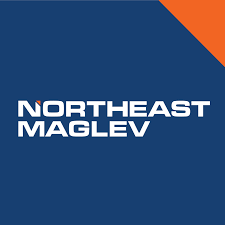
Northeast Maglev is a private U.S. company proposing a maglev train system in the Northeastern United States. The company aims to use the SCMaglev superconducting maglev system developed by the Central Japan Railway Company to provide 15-minute service between Baltimore and Washington, D.C., with an intermediate stop at BWI Airport, and ultimately connect major Northeast metropolitan hubs and airports with a goal of one-hour service from Washington, D.C., to New York City.

Sergio Salvioni (1927-2017) was a Swiss politician and a member of the Swiss Council of States from the Canton of Ticino. He was the son of Arturo and Erminia Salvioni and grandnephew of Prof. Carlo Salvioni, professor of philology and dialectology at the University of Pavia.

In addition to the direct reduction in travel times the HSR project will produce, there are also economic and environmental impacts of the high-speed rail system. These were also specifically noted in Proposition 1A at the time the project sought authorization from the voters of the state in 2008. The anticipated benefits apply both generally to the state overall, as well as to the regions the train will pass through, and to the areas immediately around the train stations.













